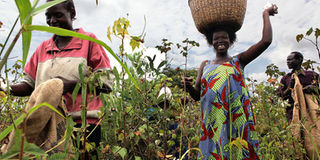Textile industry potential crippled by low funds, policy hurdles

The cotton sector has in the last five years registered improvements both in value and volumes. File Photo.
What you need to know:
About 90 per cent of Uganda’s cotton is exported in unprocessed form, which leads to the loss of billions of shillings in revenue.
Efforts to revive Uganda’s textile industry continues to stall, leading to the loss of about Shs500 billion in the exportation of unprocessed cotton.
Uganda exports at least 95 per cent of its cotton as lint (primary form as lint) as value addition continues to elude the industry due to a delayed implementation of the National Textile Policy.
The National Textile Policy was formulated in 2009, debated and passed, however the implementation of the policy continues to be one of the industry’s biggest challenges.
“The policy implementation intended to put in place various blocks through which the sector would develop. All these were agreed on at Cabinet level but one wonders why there seems to be reluctance in terms of implementation,” says the Uganda Textiles and Garment Manufacturers Association, secretary general.
Mr Samuel Ssenkungu, the director in charge of Trade Industry and Cooperatives at the Ministry of Trade believes that some of the major reasons hindering the policy’s implementation is the lack of funds.
“The policy suggests that all government primary schools in the country must buy uniforms produced within the country, however this has since stalled, he says.
He adds: “The biggest challenge is transferring the policy recommendations to respective ministries during the budgetary formulation process.”
Opportunities
In the last five years, Uganda has registered a production of 254,000 with each bale weighing 185 kilogrammes compared to 15,000 kilogrammes produced during the same period.
This, according to experts clearly represents some good potential for Uganda’s cotton industry although there is still lack of value addition.
Less than 10 per cent of Uganda’s annual out-put is processed locally and 90 per cent is exported.
Available information indicates that there is adequate ginning capacity, which has increased from 100,000 bales to 1,000,000.
The Cotton Development Organisation (CDO), a statutory body, which regulates and promotes the cotton industry in Uganda, continues to strive to revive the pre-1972 annual production levels of about 500,000 bales per annum.
Standing at about 33 million, about 180 million meters of cloth are required per annum at the per capita average of six meters to dress Ugandans.
This, according to statistics translates into a market average of over Shs350 billion annually.
The National Textile Policy says with an East African population of 120 million people, the region has a market potential of that can consume 820 million meters of cloth per annum, generating about ShsShs1.4 trillion.
Given the chance Uganda’s cotton would also have a market potential of 400 million people living among the Comesa member states.
Such kinds of market sizes would be significant to attract investors in addition to the European Union and the Agoa market initiative.
Production and exports
However, the market potential available has not been utilized with about 90 per cent of Uganda’s lint exported.
Uganda has more than 38 cotton lint exporters with some doing ginning.
The lack of value addition makes Uganda fetch far less revenues than what others that add value benefit in terms of sales.
Whereas a kilogramme of exported cotton fetches approximately $1, a twofold piece of made-up cloth made from the same quantity of lint can fetch at least $8.
This is in addition to the creation of other merits that come with the industry including employment.
This means that whereas Uganda earned $46.9 million from the 254,000 bales of cotton produced in the early 2000s, the same cotton would generate about $375. 9 million if it had been exported in a processed form.
The expulsion of Asians in the 70s disrupted the cotton subsector that had for some years become Uganda’s lead export.
The expulsion forced some industries to collapse, cutting down production of the crop and industrial capacity.
However, there is some renewed hope as production continues to register some steady growth with an average of 250,000 bales per annum.
The increase registered in the last five years puts the country in a good position considering its miserable production of about 65,000 bales in the same period.
The production of cotton in Uganda is characterized by small-holder farmers, many of whom lack appropriate farming skills.
In many cases, farmer groups are not well organised and the organisational structures themselves are weak while in most of the cases, there are no farmer groups at all.
This aspect constrains capacity building for farmers and their ability to adopt new technology.
Due to weak organization, farmers also have limited influence on policy decisions.
Smallholder farmers also face a problem with low yields mainly due to poor agronomic farm practices.
The African average yield of 379 kilogramme/ha is way below competing countries such as China with 1,270 kilogramme/ha, Israel with 1,700 kilogrammeg/ha and a world average of 589 kilogramme/ha.
However Dr Okasai Opolot, the director crop resources at the Ministry of Agriculture says Uganda could at least raise its production to 1 million bales by at least 2018.
“We believe if there are incentives for farmers in terms of technological upgrade the country has the capacity to produce cotton,” he says.
Markets
Uganda is a member of various trading regimes including the East African Customs Union, Comesa, EPAs, Agoa and EBA, which guarantees broad market access.
At a more regional level, for example, Comesa offers a market potential of 400 million people that require at least about 2.4 billion metres of clothes per annum, at an average per capita consumption of six metres.
Uganda also has the Agoa and EPA duty and quota free access to both the US and the European Union.
However, access to those markets has been constrained by the inability to have internationally acceptable fabric standards.
Efforts
The Cotton Development Organisation is seeking for ways through which it can plug distortions in Uganda’s cotton value chain.
Data from CDO shows that because of some interventions, the national average yields of seed cotton have improved from 625 kilogrammes per hectare in 1994 to 1,250 kilogramme per hectare in 2010.
Dr Opolot says the Ministry of Agriculture has set up a credit support initiative for farmers in the post-harvest handling technologies with a view of helping them to handle quality control along the value chain.
Whereas the sub sector is considered to be performing below potential, it employs over 2.5 million Ugandans, most of whom are women and youth.
The Ugandan textile sub sector was founded in the 1950s, spearheaded by the Uganda Development Corporation (UDC) that worked hand in hand with international partners like the Calico Printers of the United Kingdom and Yamato International as well as other Asian families.
Under the auspices of UDC, a National Textile Board was established in the late 1960s to guide the subsector with a view of substituting garment imports.
Due to market distortions, the current consumption of cotton lint is estimated to be about 15,000 bales per annum against the highest annual production of 250,000 bales per annum in the last five years.




